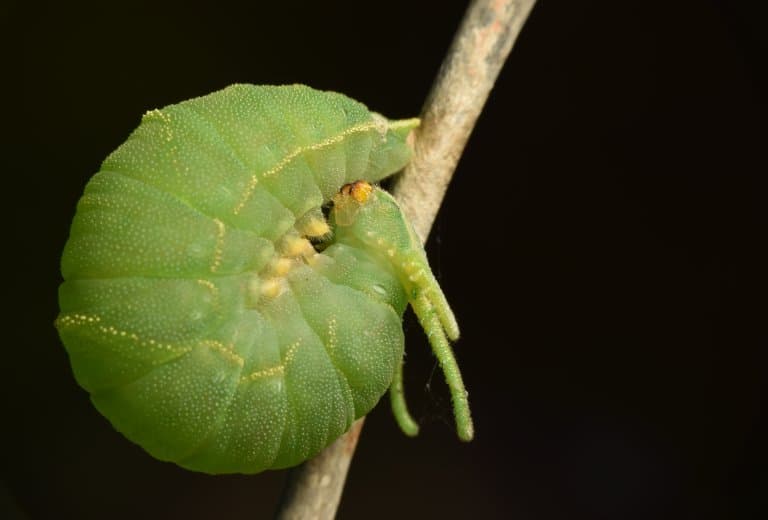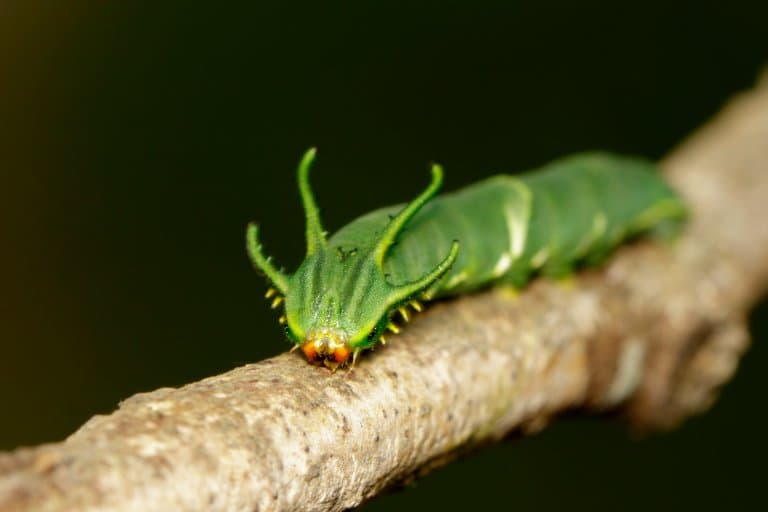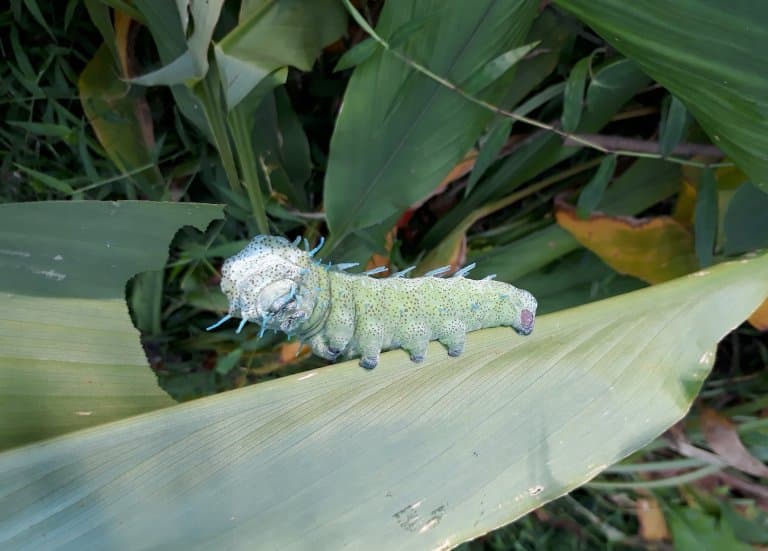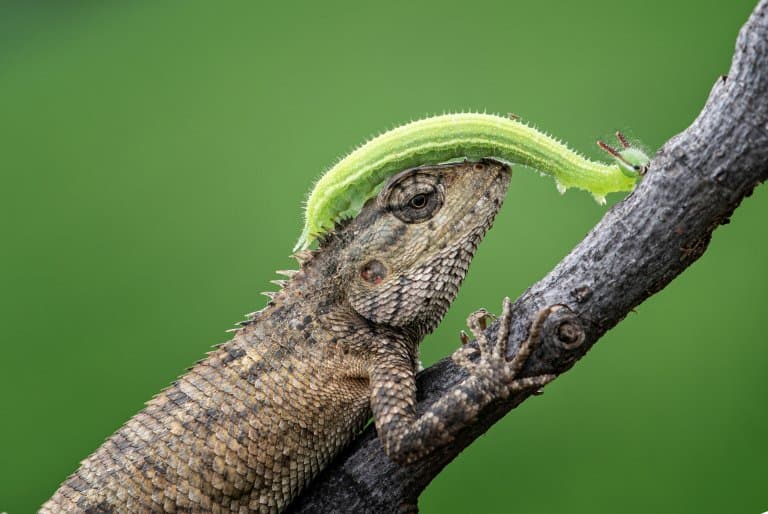Dragon Headed Caterpillar Profile
Found in temperate regions across nearly every continent except Antarctica, there’s no mistaking the dragon headed caterpillar.
Despite having nearly 400 variations in this species, dragon head caterpillars are known for the tell-tale “head capsules” which resemble wide set horns.

Dragon Headed Caterpillar Facts Overview
| Habitat: | Temperate or topical forests and areas |
| Location: | North and South America, Asia, and Australia |
| Lifespan: | 1 month |
| Size: | 3mm to 6mm (1st instar) 30 mm (5th instar) |
| Weight: | Unknown |
| Color: | Green with either green or black head. White or red markings are not uncommon. |
| Diet: | Leaves and other vegetation |
| Predators: | Birds and amphibians |
| Top Speed: | 5mph |
| No. of Species: |
400+ |
| Conservation Status: |
Least concern |
Dragon headed caterpillars can come in a variety of shapes and colors. They are herbivores and are the larvae of several different species of butterflies.
Other than their appearance, dragon headed caterpillars aren’t too different than the average caterpillars you may find in your yard.
Once they’re hatched and in the world, you’ll be able to find them munching on their favorite leaves until they’re ready to undergo metamorphosis.
Interesting Dragon Headed Caterpillar Facts
1. Like other caterpillars, the dragon headed caterpillar will grow into a butterfly.
While it may seem strange, this fierce and even intimidating caterpillar won’t look like this forever.
The dragon headed caterpillar only represents a small fragment in the life of a butterfly, the common nawab to be exact. Once it undergoes metamorphosis, this tiny dragon will trade its bright green and horns for brightly color wings.

However, before the dragon headed caterpillar is no more, they’ll spend some time in a pupa (also known as a chrysalis or less formally a “cocoon”). For many species, the dragon headed caterpillar’s pupa looks just like their larval form, with bright green and sometimes white markings.
What butterfly a dragon headed caterpillar will turn into depends on exactly what species they are.
2. There are 400 species of dragon headed caterpillar.
While this may seem like a big number on its own, its actually a bit more complex than that. You see, the dragon headed caterpillar isn’t technically a species on its own: it’s the larval (baby) stage that is shared between 400 species of butterflies.

Also, the plain nawab’s larvae is the most distinctive, with its bright green slug-like body and black horns. Some have completely green heads, however, while others may even have bright red markings. 1
3. Some variations can pack a painful sting!
For many variations of the dragon headed caterpillar, their head capsules with four horns are enough to intimidate predators and keep them off the menu for another day. However, some variations like to take other precautions, which involves a venomous sting.

While some animals may go out of their way to utilize this stinging ability, such as scorpions or other stinging critters on the offense, the dragon headed caterpillar takes a more passive approach. This means that their sting will only hurt those who pick them up, such as a hungry bird. As long as you don’t touch them, however, you won’t need to worry.
And, don’t worry– not all variations have this painful sting. But when you’re not sure which one does, it might be better to not handle them at all!
4. They eat their own eggs.
But not in the way you might be thinking! While there are dozens of species in the world who might end up on their parents’ menu, the dragon headed caterpillar prefers to eat its own egg after it hatches.
By eating their own egg after hatching, dragon headed caterpillars are able to start their life on the right foot with the nutrients they need to continue searching for other food.
5. Sometimes dragon headed caterpillars change colors.
For many species and variations of the dragon headed caterpillar, they’re born with completely black heads. However, as they continue to grow, their appearance can change in more ways than size alone.

For some, this involves their head fading from black to green. They may even develop a few new colors and markings, such as white stripes or red tips on their horns. However, some dragon headed caterpillars will keep their black head capsule until they become butterflies.
6. Their appearance depends on where they live.
With some many variations and changes in appearance, you may be wondering if there’s any rhyme or reason to. You’ll be surprised to know it isn’t entirely random!
The dragon headed caterpillar’s iconic head capsule is used for more than decoration: it helps them survive. As a result, depending on the region and predators, dragon headed caterpillars may look a bit different depending on where they live. These changes in appearance helps ensure that they’ll have a better chance of surviving to adulthood.
7. Dragon headed caterpillars have five stages of life.
There are five stages in a dragon headed caterpillar’s life, each one known as an instar. During each stage or instar, they’ll molt and grow a little larger. By the end of their fifth instar, these little caterpillars that started as small as 3mm will have grown ten times in size, with many measuring up to 30 mm!
Not too sure just how big 30mm is? That’s a few millimeters shorter than the diameter (length from side to side) of a United States quarter!
8. There’s still a lot unknown about these fascinating caterpillars.
Despite having over 400 species all around the world, there’s still a lot we don’t know for sure about these critters. For some species, we aren’t even sure how long they live!

However, we learn more and more about the dragon headed caterpillars all the time, from small discoveries like the where we can find their eggs to larger discoveries like new classifications.
Dragon Headed Caterpillar Fact-File Summary
Scientific Classification
| Kingdom: | Animalia |
| Phylum: | Arthropoda |
| Class: | Insecta |
| Order: | Lepidoptera |
| Family: | Nymphalidae |
| Genus: | Charaxes |
| Species Name: |
Polyura Athames (most common) |
Fact Sources & References
- Crew, Bec. “The adventures of the dragonhead caterpillar.” Australian Geographic. January 6, 2014.
